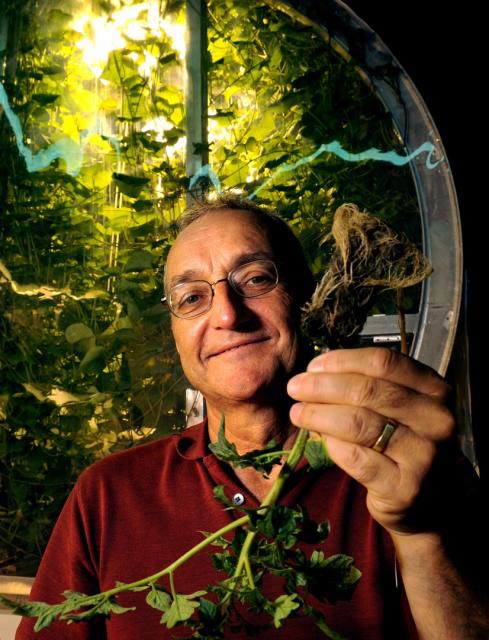Lunar Greenhouse Could Grow Food For Future Moon Colonies

A newcollapsible "greenhouse" could be the key to growing fresh andhealthy food to sustain future lunar or Martian colonies, a recent projectfound.
Scientistsat the University of Arizona's Controlled Environment Agriculture Center (CEAC)are experimenting with growing plants without the use of soil. Instead, theyare trying to demonstrate that potatoes, peanuts, tomatoes, peppers and othervegetables can be grown in only water?a process known as hydroponic growth.
The teambuilt a prototype lunar greenhouse in the CEAC Extreme Climate Lab that ismeant to represent the last 18 feet (5.5 meters) of one of several tubularstructures that would form part of a proposed lunar base.
The tubeswould be buried beneath the moon's surface to protect the plants and astronautsfrom deadly solar flares, micrometeorites and cosmic rays. As such, the buriedgreenhouse would differ from conventional greenhouses that let in and capturesunlight as heat. Instead, these underground lunar greenhouses would shield theplants from harmful radiation.
Greenhousebasics
Themembrane-covered greenhouse module can be collapsed down to a 4-foot-wide diskfor easy storage during interplanetary travel. It would be fitted with water-cooledsodium vapor lamps and long envelopes that would be filled with seeds, primedto sprout hydroponically.
"We candeploy the module and have the water flowing to the lamps in just tenminutes," Phil Sadler, president of Sadler Machine Co., which designed andbuilt the lunar greenhouse, said in a statement. "About 30 days later, youhave vegetables."
Get the Space.com Newsletter
Breaking space news, the latest updates on rocket launches, skywatching events and more!
Thecontraption will rely on robot-like components to grow its organic life.Algorithms to analyze data collected by attached sensors and a control systemto optimize performance are in the works.
"Wewant the system to operate itself," said Murat Kacira, an associateprofessor of agricultural and biosystems engineering at the University ofArizona. "However, we're also trying to devise a remote decision-supportsystem that would allow an operator on Earth to intervene. The system can buildits own analysis and predictions, but we want to have access to the data andthe control system."
In fact, theengineers can take cues from an existing analog on Earth?a similar CEACfood-production system has been operating at a South Pole research station forthe past six years.
The SouthPole Growth Chamber, which was also designed and fabricated by Sadler MachineCo., provides fresh food to the U.S. South Pole Station in Antarctica, which isphysically cut off from the outside world for six to eight months each year.
Severalideas used in the development of the lunar greenhouse were inspired by thefunctioning South Pole Growth Chamber.
Otherapplications
Anotherimportant aspect of the greenhouse design is the effective and efficient use ofresources, which would be crucial on a lunar base.
"Onanother planet, you need to minimize your labor, recycle all you can andoperate as efficiently as possible," said principal investigator and CEAC directorGene Giacomelli.
Indeveloping such a system, there will likely be applications for our planet aswell, he said. "All that we learn from the life support system in theprototype lunar greenhouse can be applied right here on Earth."
Carbondioxide is fed into the prototype greenhouse from pressurized tanks, butastronauts would also provide CO2 at the lunar base simply bybreathing. Similarly, water for the plants could be extracted from astronauturine, and the water-cooled electric lights might be replaced by fiber opticcable?essentially light pipes?which would channel sunlight from the surface tothe plants underground.
Giacomellisaid the research could also lead to plant colonization in anothertraditionally hostile environment?large urban centers.
"There'sgreat interest in providing locally grown, fresh food in cities, for growingfood right where masses of people are living," Giacomelli said. "It'sthe idea of growing high-quality fresh food that only has to be transportedvery short distances. There also would be a sense of agriculture returning tothe everyday lives of urban dwellers. I think that idea is as exciting asestablishing plant colonies on the moon."
- Images ? Moon Bases of the Future
- Greatest Apollo Hoaxes: Did We ReallyLand On the Moon?
- NASA's New Direction: FAQ
Join our Space Forums to keep talking space on the latest missions, night sky and more! And if you have a news tip, correction or comment, let us know at: community@space.com.

Space.com is the premier source of space exploration, innovation and astronomy news, chronicling (and celebrating) humanity's ongoing expansion across the final frontier. Originally founded in 1999, Space.com is, and always has been, the passion of writers and editors who are space fans and also trained journalists. Our current news team consists of Editor-in-Chief Tariq Malik; Editor Hanneke Weitering, Senior Space Writer Mike Wall; Senior Writer Meghan Bartels; Senior Writer Chelsea Gohd, Senior Writer Tereza Pultarova and Staff Writer Alexander Cox, focusing on e-commerce. Senior Producer Steve Spaleta oversees our space videos, with Diana Whitcroft as our Social Media Editor.









